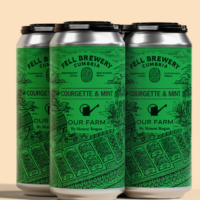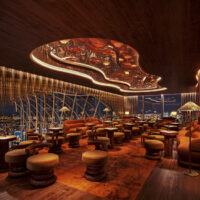WLC‘s resident glutton, Lucy Shaw, heads to Arros QD in Fitzrovia for exploding pasta parcels, deconstructed steak tartare and a game changing seafood paella.

At Arros QD the paellas are cooked over different types of wood in an open kitchen
The concept: While little known in London, Quique Dacosta is a big deal in Spain. The Extremadura-born, Valencia-raised chef has held three Michelin stars at his eponymous flagship restaurant in Denia since 2013, and has four other sites in Spain to his name, including the popular Michelin-starred El Poblet in Valencia.
Keen to shine a light on Valencia’s signature dish, and challenge diners’ perceptions of Spanish cuisine while he’s at it, in June Dacosta opened his long-awaited paella palace, Arros QD (after the Catalan word for rice), in London’s buzzy Fitzrovia, sending the capital’s foodies into a frenzy.

The burnt orange and black interiors are inspired by fire and ash
Dacosta couldn’t be more serious about paella, which, he believes, should be prepared the way James Bond likes his Martinis – shaken not stirred.
Valencians are fiercely proud of their regional staple, which took on its modern incarnation in the mid-19thcentury. The classic version is made with chicken, rabbit, butter beans and saffron, which gives it its glorious golden colour.
Jamie Oliver caused outrage in Spain in 2016 when he deigned to include chorizo in his contemporary twist on the dish. Keeping thing traditional, Dacosta’s paellas are cooked over a wood fire, which acts like seasoning, imbuing the ingredients with an appealing smokiness.
The décor: With its black tiled walls, gold cutlery and statement chandeliers, the décor is ‘90s New York bachelor pad with a lick of Liberace. The black and burnt orange colour scheme is said to be inspired by ash and flames. Like Argentine meat maestro Francis Mallmann, Dacosta seems mesmerised by the primitive beauty of an open fire.
The cavernous 140-cover space is split across two floors via a statement spiral staircase. Entering the restaurant feels like walking into a high-end hotel in LA, with its sleek black lobby and immaculately attired staff.
At the top of the staircase is a destination cocktail bar serving refreshing seasonal sips. Downstairs in the main restaurant, diners can watch the drama unfold from the open kitchen. The paellas are prepared in ginormous shallow pans that bubble away excitedly in full view of the diners.
The food: Visiting during the heatwave, keen for an expert opinion, I brought along my paella-mad Valencian friend Nuria, who was raised on the dish. A stickler for detail, Dacosta uses different woods, including beech, apple, orange, pine and even vine cuttings, for different twists on the dish.
Championing contemporary Mediterranean cuisine, there’s more to Arros QD than rice. Our feast began with two playful amuse bouche. The first was a pair of black pebbles, which, when bitten into, revealed soft creamy centres charged with the intense, umami-rich flavours of Parmesan and Manchego. The only disconcerting element of the curious nibble was its almost ice-cold temperature.

Flappingly fresh: scallop tiradito
Much more successful were the truffle bombs – pretty little parcels that exploded with a salty, bacon-laced liquid that reminded me of Frazzles in a deconstructed spaghetti carbonara kind of way.
Drifting away from the Med for a moment, a scallop tiradito starter (£17) saw pearlescent discs of the shellfish served in a luminous pool of canary yellow, lime-laced aji amarillo flecked with cooling fronds of dill in a flappingly fresh ensemble.
The beef tartare (£18) is a divisive dish you’ll love or hate. Bearing the hallmarks of Dacosta’s three star pedigree, the dish has been fine-tuned and reimagined, and looks like an edible artwork masquerading as a giant fortune cookie.
The iron-rich meat is interspersed on the buttery cracker with detonating mustard seeds, edible flowers, cured egg yolk and capers in a kooky twist on the French classic.
Signature dishes: During a tour of the furnace-like open kitchen, I’m told that the secret to a delicious paella is nailing the stock and creating a scrapable layer of crispy rice at the bottom of the pan packed with savoury flavour.
Going against the grain of the current trend for fast casual dining, Dacosta is keen for Londoners to slow down and chill out – his traditional paellas take time to both cook and eat, and are designed to be shared during lazy lunches and decadent dinners that carry on late into the night.

Steak tartare with a twist
Bypassing the rabbit-laden classic version (£35), we opted instead for the Mediterranean paella (£50), decorated with hunks of monkfish, cubes of cuttlefish and six squiggly, sensationally silky tiger prawns from San Lucár de Barrameda in Jerez.
The dish was a revelation, and tasted so vastly different to every other paella I’ve ever had, it made me realise I’ve been eating it wrong all my life. Dacosta’s paellas are elegant and refined, and elevate the dish to a new realm.
While the seafood was delicious, the rice was the star of the show. Rather than mounds of fluffy saffron yellow shards, it was the colour of caramel and offered a sublime hit of savoury flavour bearing the trace of the seafood stock. The rice was so good I would have been happy with a naked version bereft of toppings.
Making the dish all the more magnificent was an exciting assortment of aioli accompaniments – glossy mounds of garlic mayo flavoured with black garlic, red pepper and porcini, which, when slathered generously over the rice, created a heavenly explosion of umami flavours.
Scraping the last delicious scraps from the bottom of the pan, Nuria declared the paella to be as good if not better than any she’s enjoyed back home in Valencia, save for her mother Carmen’s.

Dacosta’s gargantuan Mediterranean paella
The drinks: While the wine list is worth exploring, the cocktails merit a look too. My Pera, which blended Patrón Reposado Tequila with Grey Goose La Poire, white grape juice, bergamot liqueur, lime and pear cider proved an invigorating apéritif and wonderfully cooling on a scorching night.
The wine list celebrates Spain and South America, with high calibre Cava producer Gramona’s La Cuvée Gran Reserva 2011 on pour by the glass for a reasonable £11. Sherry lovers can also get their fix from as little as £7, for a glass of Tio Pepe En Rama.
Juan, our Spanish sommelier, poured me a glass of Miguel Torres La Causa Moscatel from Itata in Chile (£10), which was packed with bright, zippy citrus flavours rather than the flower bomb aromatics I’ve come to expect from the grape.
On the red front, Juan kept things traditional a Valencian Bobal made by Bruno Murciano, who swapped a successful sommelier career in London to make wine in his homeland. His Alegria Bobal (£11) was juicy and fruit forward with an appealing hint of smoke.
Don’t leave without: Sneaking a peek upstairs to give you a feel for the magnitude of the venue, which allegedly cost Dacosta £4.3m to create.
Last word: If you’re keen for a taste of authentic Valencian paella cooked by one of Spain’s most daring and decorated chefs, then a visit to Arros QD is a must. While prices can get steep – the Canadian lobster paella costs £85, the traditional version is a bargain at £35, as all are big enough to happily feed three.
Whether the restaurant is robust enough to weather the ongoing storm of Brexit and London’s habit of forever seeking out new culinary experiences remains to be seen, but the intense savoury taste of the rice was a revelation. These paellas are so good you’ll be fighting your friend for the last glossy grain.
Arros QD, 64 Eastcastle Street, London W1W 8NQ; Tel: +44 (0)20 3883 3525




